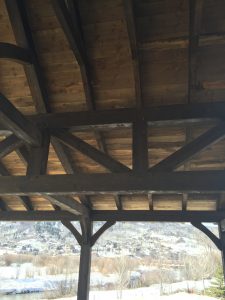A timber frame colleague of mine once said “the only thing worse than having an architect involved is NOT having an architect involved”.
We are not architects, nor do we claim to be. So when we talk about timber frame design, it comes from an engineering & constructability perspective. Having engineered timber frames for the past 10 years, we have a pretty good idea whether or not a structure will “work”.
From the construction side, the simplification of joinery and the sequencing of raising the frame play a huge roll in reducing costs.
Let’s look at the Rotary Club Peace Pavilion in Steamboat Springs as an example.The original frame design from the architect included three principle frames, or bents, with connecting purlin & ridge beams to support common rafters. This was based on the desire to have the interior fully open & free of any posts or columns. The large design snow loads created a significant increase in the tensile forces in the center bent truss. This resulted in larger timbers and would have required steel rods to resist theses forces.
We provided an alternative design which included two parallel chord (flat) trusses that were able to clear span the space below and satisfy the open area the client was looking for, with a minimal change to the overall look of the structure. Although the assembly of these trusses was a bit more tedious, the overall frame went up a lot faster, thus reducing field labor costs. This also allowed us to bump down the beam & rafter sizes, as well as eliminate the steel tension rods.
Ultimately, by simply redesigning the frame, we we’re able to save the client a few dollars, and more importantly, they liked the new frame design better than the original concept. So did the architect!The point of this is example is that we are not necessarily substitutes for hiring an architect, but getting Kenai Timber Frames involved early in the design process will have a substantial impact on both the cost savings and the aesthetics of the final structure!


